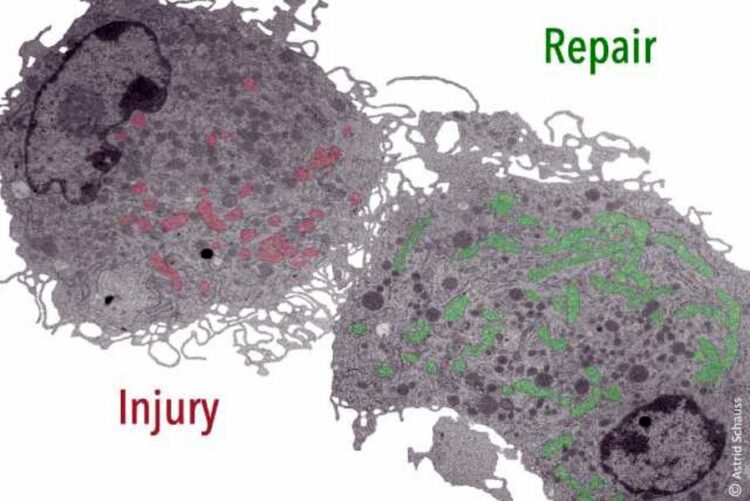Defense or repair: How immune cells are controlled during wound healing

Injury-associated macrophages require metabolic reprogramming to drive the wound healing response. Pseudocolored mitochondria show different mitochondrial yield and shape in early (red) versus late (green) wound macrophages.
(c) Astrid Schauss
For the first time, scientists show a causal link between tissue repair, mitochondrial metabolism, and the activation and function of macrophages (scavenger cells) / Publication in ’Cell Metabolism’.
A Cologne-based research team has discovered that the metabolism of mitochondria, the energy suppliers of cells, in macrophages coordinate wound healing to a significant degree. Macrophages belong to the white blood cells and are also known as scavenger cells. Professor Dr. Sabine Eming and her collaborators and colleagues at the CECAD Cluster of Excellence for Aging Research at the University of Cologne showed that wound macrophages undergo different metabolic programs during tissue repair, which are required to support the successive phases for skin reconstruction after injury.
The article ‘Mitochondrial metabolism coordinates stage-specific repair processes in macrophages during wound healing’ has now been published in Cell Metabolism.
In the human body, macrophages can adopt different activation states. As pro-inflammatory macrophages in the early phase of wound healing, they kill bacteria or viruses and initiate a protective defense response. Reparative macrophages of late wound healing support the resolution of inflammation so that tissue can build up and equilibrium can be restored.
An unresolved question in macrophage biology is what signals are required for the transition from inflammatory to reparative macrophages. In the new study, Eming, senior physician at the Department of Dermatology and Venereology and research group leader at CECAD and the Center for Molecular Medicine Cologne (CMMC), and her team demonstrated a functional link between tissue repair, cell metabolism, and the activation and function of tissue-repairing macrophages. Changes in mitochondrial metabolism are the critical control mechanism for the different functions of macrophages during early and late wound healing.
In an animal model, the scientists studied the metabolism of macrophages in the early and late wound healing states. They found that sugar metabolism in the early phase is not sufficient to ensure productive repair. Using single-cell sequencing, the team discovered that a subpopulation of early-stage macrophages metabolizes reactive oxygen radicals produced in mitochondria as a byproduct of cellular respiration.
Eming and the team were able to show for the first time that the benefit of the reactive oxygen-containing molecules in early wound macrophages is essential to ensure the growth of blood vessels, and thus timely healing. In contrast, macrophages use a different type of mitochondrial stromal exchange mediated by specific receptors (IL-4Ra) for their anti-inflammatory and reparative functions in the late phase of wound healing.
‘Based on our results, it will be very interesting to understand whether disturbed mitochondrial stress in cells of the immune system contribute to aberrant inflammatory responses in the skin and pathological wound healing states,’ said Eming. ‘It will also be exciting to see if pharmacologic intervention in mitochondrial stress responses provides therapeutic benefit and facilitates the repair of injured tissue.’
Media contact:
Professor Dr Sabine Eming
+49 221 478 3196
sabine.eming@uni-koeln.de
Press and Communications Team:
Dr Anna Euteneuer
+49 221 478 84043
anna.euteneuer@uni-koeln.de
Publication:
https://www.cell.com/cell-metabolism/pdf/S1550-4131(21)00482-4.pdf
Media Contact
All latest news from the category: Life Sciences and Chemistry
Articles and reports from the Life Sciences and chemistry area deal with applied and basic research into modern biology, chemistry and human medicine.
Valuable information can be found on a range of life sciences fields including bacteriology, biochemistry, bionics, bioinformatics, biophysics, biotechnology, genetics, geobotany, human biology, marine biology, microbiology, molecular biology, cellular biology, zoology, bioinorganic chemistry, microchemistry and environmental chemistry.
Newest articles

Sensitive ceramics for soft robotics
Most people think of coffee cups, bathroom tiles or flower pots when they hear the word “ceramic”. Not so Frank Clemens. For the research group leader in Empa’s Laboratory for…

‘Entirely unanticipated’ role of protein netrin1 in spinal cord development
Known for its axon guidance properties, new research suggests protein is critical in guiding neural development. Scientists at the Eli and Edythe Broad Center of Regenerative Medicine and Stem Cell Research…

AI to improve brain cancer diagnosis, monitoring, treatment
Recommendations published in The Lancet Oncology call for good clinical practice of new technologies to modernize decades-old standard of care for brain cancer patients. An international, multidisciplinary team of leading…



